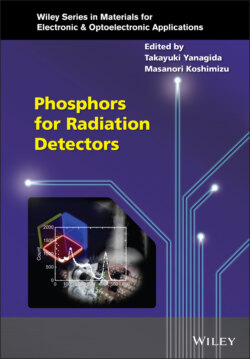Читать книгу Phosphors for Radiation Detectors - Группа авторов - Страница 16
1.3 Scintillation 1.3.1 Energy Conversion Mechanism
ОглавлениеFigure 1.3 shows typical emission mechanisms of a scintillator assuming a combination of the host and the dopant for the luminescence center. When the incident ionizing radiation is absorbed by the ionizing radiation‐induced luminescent materials, many secondary electrons (i.e., δ‐rays, or carriers in a semiconductor field) are generated via electromagnetic interaction such as Coulomb scattering. In the case of X‐ or γ‐ray irradiation, one primary electron is generated by one of the three interactions, including photoelectric absorption, Compton scattering, and pair creation, and the primary electron can excite many secondary electrons. In spite of the species of the incident ionizing radiation, many secondary electrons are generated, and the number of them is proportional to the incident energy of the ionizing radiation if we assume the irradiation of a single quantum. This first process is called the conversion process, and the typical time scale of this process is extremely fast (as ~fs). After the generation of a large number of secondary electrons, these electrons dissipate their kinetic energy via the interactions with each other or the host lattice. If some electrons can directly reach the dopant sites (luminescence centers), they can recombine with the holes, and we can observe an emission. This process is a diffusion process of secondary electrons, and is called an energy transportation process with a time scale of ps. In addition to the recombination, some secondary electrons directly excite the electron at the luminescence center, and we can also observe an emission by the relaxation of this excited electron at the luminescence center. Emission caused by these processes is called scintillation, and this final stage is known as the luminescence (or emission) process. The time scale of the luminescence process depends on the emission mechanism or dopant ion. For example, if the dopant shows a 5d‐4f transition, a typical time scale is several tens to hundreds of ns.
Figure 1.3 Typical emission mechanisms of scintillation.
The final process of the scintillation is the same with photoluminescence (PL), and we may have a question about the difference of the scintillation and PL. Although no standard definition has been put forward, we (the authors of this book) consider that the interactions of excited secondary electrons is necessary for scintillation. In PL, generally one UV or Vis photon can excite one electron in the outer orbital, and we observe an emission by the relaxation of this excited electron. In this case, the excited electron does not interact with other electrons. In the case of the direct band‐gap excitation of semiconductor‐type phosphor, the interaction of the excited electron with other electrons may be possible. But typical UV or Vis excitation energy is not so high, and the excited electron does not have enough energy to interact with the other electrons in most cases. Thus, the excitation of multiple electrons by quanta and interactions of these multiple electrons will be the main difference of scintillation with PL. In other words, if we consider typical insulator or semiconductor materials, at least several tens of eV of excitation energy will be required to cause scintillation, and excitation below this energy will be PL. Of course, the threshold energy of scintillation and PL depends on the materials used. In the case of small band‐gap materials, the excitation energy of several eV may be enough to cause scintillation.
